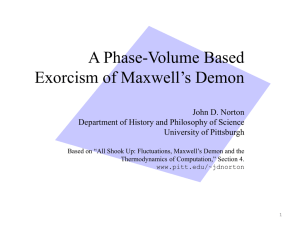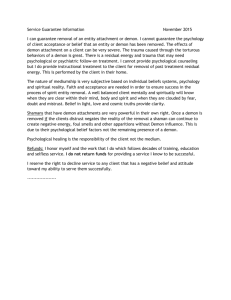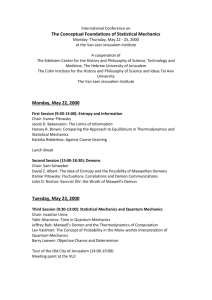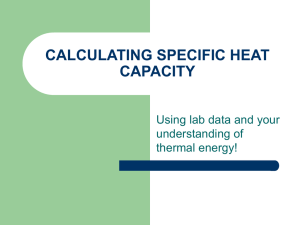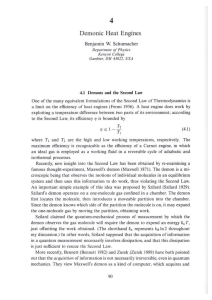Recent Developments in Teaching Statistical and Thermal Physics Harvey Gould
advertisement
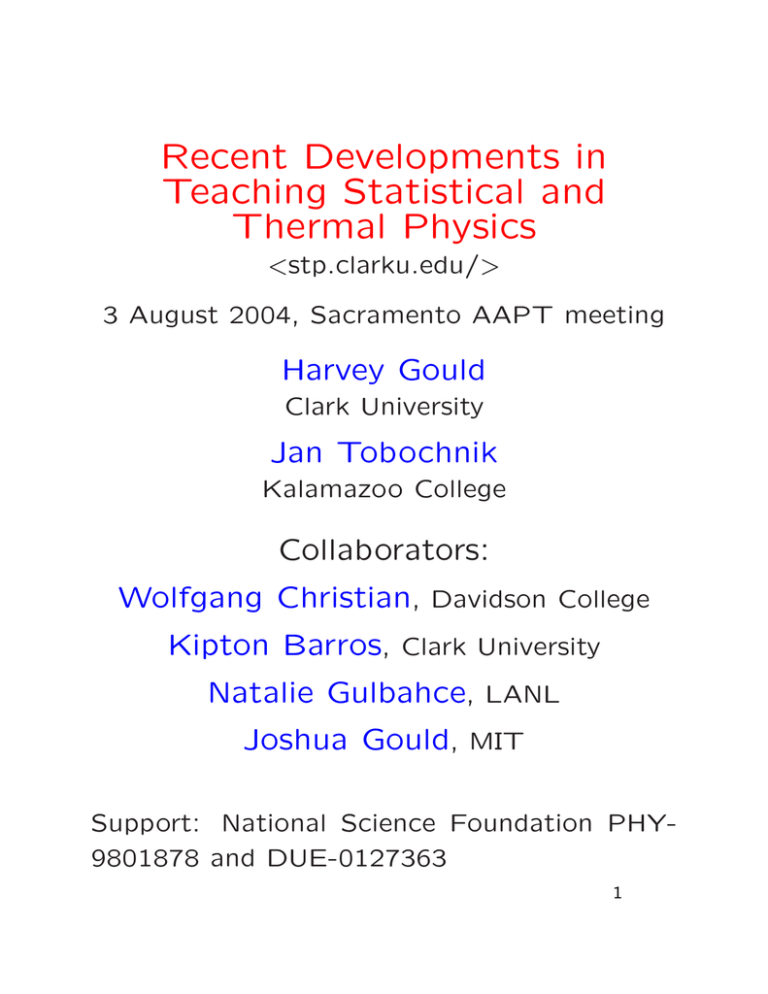
Recent Developments in Teaching Statistical and Thermal Physics <stp.clarku.edu/> 3 August 2004, Sacramento AAPT meeting Harvey Gould Clark University Jan Tobochnik Kalamazoo College Collaborators: Wolfgang Christian, Davidson College Kipton Barros, Clark University Natalie Gulbahce, LANL Joshua Gould, MIT Support: National Science Foundation PHY9801878 and DUE-0127363 1 Importance of Statistical and Thermal Physics in Contemporary Research • Much of condensed matter physics, including polymers, liquid crystals, fluid mixtures, and lipids. • Bose-Einstein condensation. • Nanophysics. • Energy and the environment. • Analogies to gauge theories in particle physics. • The physics of stars. • The physics of disordered materials: spin glasses, porous rocks, percolation phenomena, fractals. • Non-equilibrium and complex systems: granular matter, foams, neural networks. • Econophysics. 2 Why is Statistical and Thermal Physics Difficult to Teach? • No obvious organizing principle such as Newton’s equations, Maxwell’s equations, or the principle of least action. Statistical mechanics is frequently viewed as a collection of tricks. Baierlein has suggested: – Entropy and the second law. – The canonical probability distribution. – The partition function. – The chemical potential. • Students have many misconceptions about probability. The central limit theorem is the key to statistical mechanics, but we hardly discuss it. 3 Questions and Problems • Should statistical mechanics and thermodynamics be discussed simultaneously? Are we short changing thermodynamics and not teaching students macroscopic reasoning? • Conceptual difficulties with key concepts such as T , µ, E, and S. • Students have little sense of the nature of fluctuations. • We use strange mathematical notation. S(T ) and S(E) are not the same function, but represent the same physical quantity. Many students do not understand differentials. • Need to go beyond ideal gas by considering other microscopic models such as meanfield theory and the 1D Ising model, and by using simulations to look at more realistic systems and make concepts more concrete. • Typically, there is no lab associated with the course. 4 Pitfalls to Avoid • Avoid the use of time whenever possible. Time is irrelevant for systems in equilibrium. Equilibrium is history-independent. Statistical mechanics is about counting. • Avoid using “heat” as a noun. • Entropy is not a measure of “disorder.” • The Maxwell velocity and speed distributions hold for any classical gas, not just an ideal gas. 5 Simulations • Molecular dynamics (MD) and Monte Carlo methods can make concepts more concrete. • Student view of matter is similar to grains of sand bouncing off each other. Temperature is related to the “heat” given off when particles rub against each other. • By discussing MD, we can discuss the forces between molecules. • Integration of Newton’s equations of motion shows that molecular motion is chaotic, but macroscopic quantities vary smoothly. • Internal energy E equals kinetic plus potential energy. • Temperature proportional to KE for classical systems. Show by placing two systems in thermal contact. • Pressure related to momentum transfer. 6 • Monte Carlo methods can make ensembles more concrete and illustrate ideas of probability. • Can simulate interesting physical systems including a Lennard-Jones gas, liquid, and solid, random walks, diffusion, the Ising model, and phase transitions. • It almost is as effective to explain the model and algorithm, give students the data, and ask them to analyze it. 7 Thermal Contact: What is the Temperature? 8 A Concrete Model of a Thermometer: The Demon Algorithm • “Demon” has energy, Ed, and can exchange with a system. Ed ≥ 0. 1. Begin with system in initial configuration. 2. Make random trial change in a degree of freedom in the system, for example, flip spin or move particle. 3. If ∆E < 0, then accept change and give extra energy to demon. 4. If ∆E > 0 and demon has the energy, then demon gives the needed energy to system; otherwise, change is rejected. 5. Repeat steps 3–5 many times and compute various averages. 9 Applications • Demon algorithm simulates system in the microcanonical (constant energy) ensemble. • What is P (Ed), the probability that demon has energy Ed? Example of a small system in equilibrium with a heat bath at temperature T . P (Ed) ∝ e−Ed/kT Temperature obtained from inverse slope of ln P (Ed) versus Ed. • Demon interacts weakly with system just as a real thermometer and comes to same temperature as system, just like a real thermometer. • Temperature is a measure of the ability of a system to transfer energy to another system. Temperature is not the same as energy. 10 1D, ∝ p2, E d = 1.90, E/N = 38.1/40 = 0.95 2D, ∝ p2, E d = 1.96, E/N = 78.0/40 = 1.95 1D, ∝ p, E d = 0.98, E/N = 79.0/40 = 1.98 In all three cases, E d = kT . 11 Understanding the Density of States Two key ideas in statistical mechanics: 1. Boltzmann distribution: Pn(En) ∝ e−En/kT 2. Density of states, g(E): g(E)∆E = # of states between energy E and E + ∆E. P (E) ∝ g(E)e−E/kT E −E/kT E E g(E)e E= −E/kT E g(E)e 12 Wang and Landau Method of Estimating g(E) 1. Begin with g(E) = 1 for all E, initial configuration, and parameter f = e. 2. Make a trial change in a degree of freedom. E goes from E1 → E2. 3. If g(E1) > g(E2), accept change and let g(E2) = f g(E2) and H(E2) → H(E2) + 1. 4. If g(E1) < g(E2), accept change if r≤ g(E1) . g(E2) Otherwise reject trial change and let g(E1) = f g(E1). Update H. 5. Repeat steps 2–4 until H(E) is “flat.” √ 6. Let f → f so f → 1. Repeat steps 2–5. 7. Repeat step 6 until f ≈ 1.00000001. 13 Results 14 1.6 1.5 specific heat 1.4 1.3 1.2 1.1 1 0.9 0.8 1.2 1.4 1.6 1.8 2 2.2 2.4 2.6 2.8 ln L C = C0 ln L with C0 = 0.55. Theory C0 ≈ 0.50. 15 Chemical Potential Chemical potential is a measure of the ability of a system to transfer particles. Two systems in thermal and diffusive equilibrium will not only come to the same temperature, but also will come to the same chemical potential. Chemical potential can be measured using the Widom insertion method. Z ∂F µ= = −kT ln N +1 (N → ∞) ∂N V,T ZN µ = −kT ln <e−β∆E >. To understand the chemical potential, we extend the demon algorithm so that the demon also can hold particles. Then the probability that the demon has energy Ed and Nd particles is given by the Gibbs distribution: P (Ed, Nd) ∝ e−β(Ed−µNd). 16 Generalized Demon Algorithm Tobochnik, Gould, and Machta Introduce a lattice in phase space including momentum degrees of freedom. 1. Choose configuration with energy E and N particles. Let Ed = 0 and Nd = 0. 2. Choose a lattice site in system at random. 3. If particle is present, compute the change in energy ∆E to remove particle. If Ed sufficient, Ed → Ed − ∆E, and Nd → Nd + 1, Otherwise, reject change, but include unchanged configuration in averages. 4. If no particle present and Nd ≥ 1, attempt to add particle at chosen site by computing ∆E. If ∆E < Ed, Ed → Ed − ∆E and Nd → Nd − 1. Otherwise, reject change, but include old configuration in averages. 5. Repeat steps (2)–(4), compute various averages, and accumulate data for P (Ed, Nd). 17 Typical Results 0 Nd = 0 ln P(Ed) -5 -10 Nd = 2 -15 Nd = 4 -20 0 10 20 30 40 50 60 Ed β = 0.26 18 0 Ed = 0 Ed = 3 Ed = 6 ln P(Nd) -5 -10 -15 -20 0 1 2 3 4 5 6 Nd βµ = 0.28 19 Results for Ideal Classical Gas -2 -4 µ -6 -8 -10 -12 -14 -16 -18 0 0.2 0.4 ρ 0.6 0.8 1 20 Recent TextBooks <stp.clarku.edu/books/> • Daniel Schroeder, An Introduction to Thermal Physics, Addison-Wesley (2000). Excellent problems. Very accessible. • Ralph Baierlein, Thermal Physics, Cambridge Univ. Press (1999). Reviews in Physics Today, August 2000 and AJP, December 1999. • Michael Sturge, Statistical and Thermal Physics, A. K. Peters (2003). • Ashley H. Carter, Classical and Statistical Thermodynamics, Prentice Hall (2001). • R. Bowley and M. Sanchez, Introductory Statistical Mechanics, Oxford Univ. Press (2000). • Debashish Chowdhury and Dietrich Stauffer, Principles of Equilibrium Statistical Mechanics, Wiley-VCH (2000). Advanced undergraduate to graduate level. Comprehensive and excellent historical notes. 21 More Advanced TextBooks • Daniel C. Mattis, Statistical Mechanics Made Simple, World Scientific (2003). Review in July 2004 issue of Physics Today. • Gene F. Mazenko, Equilibrium Statistical Mechanics, Wiley (2000). Review in July 2003 issue of AJP. • Craig F. Bohren and Bruce A. Albrecht, Atmospheric Thermodynamics, Oxford University Press (1998). One of the most entertaining textbooks ever written. Many practical applications. Reviewed in December 2000 issue of AJP. • Special theme issue of AJP, December, 1999. 22 Open Source Textbook Freely available from <stp.clarku.edu/notes> Gould and Tobochnik, lead authors Can the development of Linux and Apache be a model for the development of textbooks? So far, the “text” has been used as a supplement for several courses, but it has been difficult to get feedback from other instructors or to obtain contributions of anything except the correction of typos. 23 Open Source Physics Library <www.opensourcephysics.org> • Difficult to find students who know both Java and physics to help write software. • Most applets on the Web are quick “hacks.” Much of the code is taken up by graphics statements, and algorithm is not clearly separated from rest of program. Too difficult to modify programs. ⇒ Development of Open Source Physics library based on Java. Wolfgang Christian, Francisco Esquembre, Joshua Gould, Harvey Gould, Jan Tobochnik. Alternative: VPython, <http://www.vpython.org/> 24
